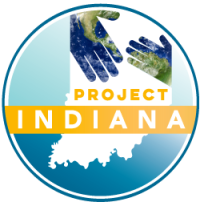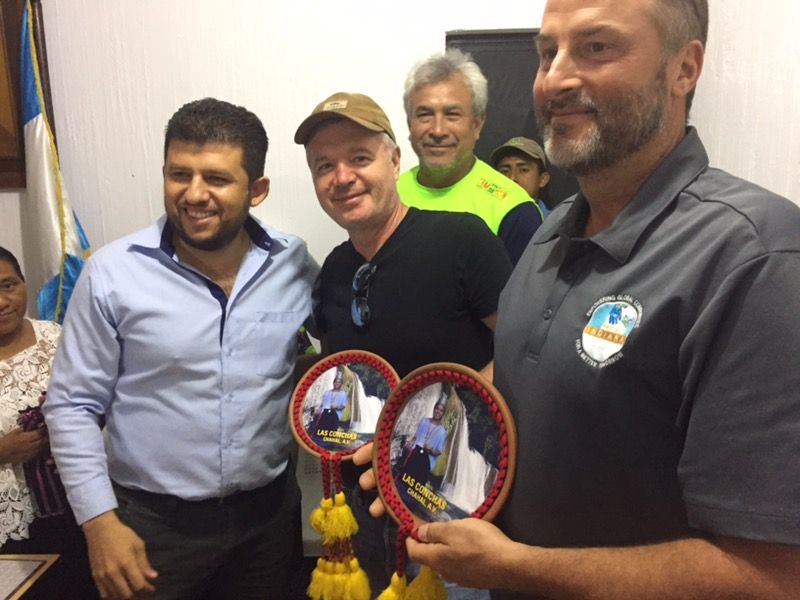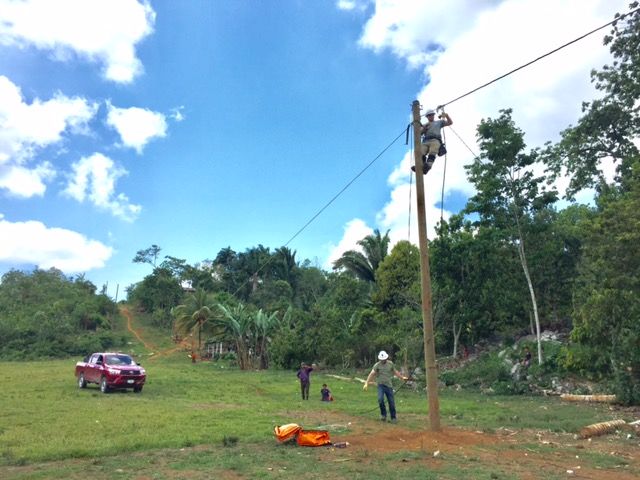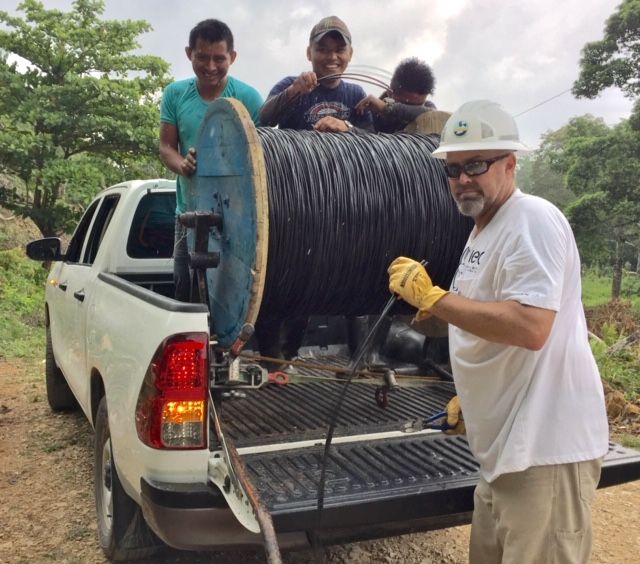Author: Mandy Barth
Fourteen lineworkers to empower a global community for a better tomorrow
Fourteen Indiana electric cooperative lineworkers will travel to Guatemala in late April as part of an international initiative to bring electricity to a developing area in Guatemala.
“Project Indiana: Empowering Global Communities for a Better Tomorrow” will bring electricity to a part of the Central American country where none is available. The crew will spend April 27 through May 13 extending electric infrastructure in the village of Peña Roja along the western edge of Guatemala. When completed, approximately 26 homes will have electricity for the first time.
Project Crew
- Matt Bassett, Tipmont
- Kevin Bay, JCREMC
- Michael Bowman, Boone REMC
- Cody Campbell, South Central Indiana REMC
- Nathan Clayton, Clark County REMC
- Collin Crabtree, Decatur County REMC
- Ethan DeWitt, Northeastern REMC
- Austin Gearlds, NineStar Connect
- Tom Gettinger, Henry County REMC
- Clint Heeke, Southern Indiana Power
- Frank Leach, Carroll White REMC
- Terry Minic, Paulding Putnam Electric Cooperative, Inc.
- Jason Morrison, Jackson County REMC
- Michael Newlin, Orange County REMC
Support Team
- Joe Banfield, Indiana Electric Cooperatives
- Jamie Bell, NineStar Connect
- Ron Holcomb, Tipmont
- Chris Todd, Northeastern REMC
This is the Indiana electric cooperatives’ fifth trip to Guatemala. In August 2012, 28 Hoosier lineworkers from 17 of Indiana’s electric cooperatives, spent four weeks working across the mountainous terrain to bring electricity to 184 homes, a church and a school in three villages. In April 2015, 14 lineworkers battled extreme heat and the rugged land to bring electricity to 164 homes, a school and a church.
In 2017, 14 lineworkers endured temperature extremes to power 68 homes, a school, a church and a health clinic. And, on the last trip in 2019, 14 lineworkers brought electricity to nearly 90 homes, two churches and a school, and ensured that every home they wired for electricity had a properly vented wood-burning cooking stove installed to replace the open fires villagers have used for years.
Follow along the crew’s journey in Peña Roja by visiting ProjectIndiana.org/PenaRoja.
A Long Travel Day
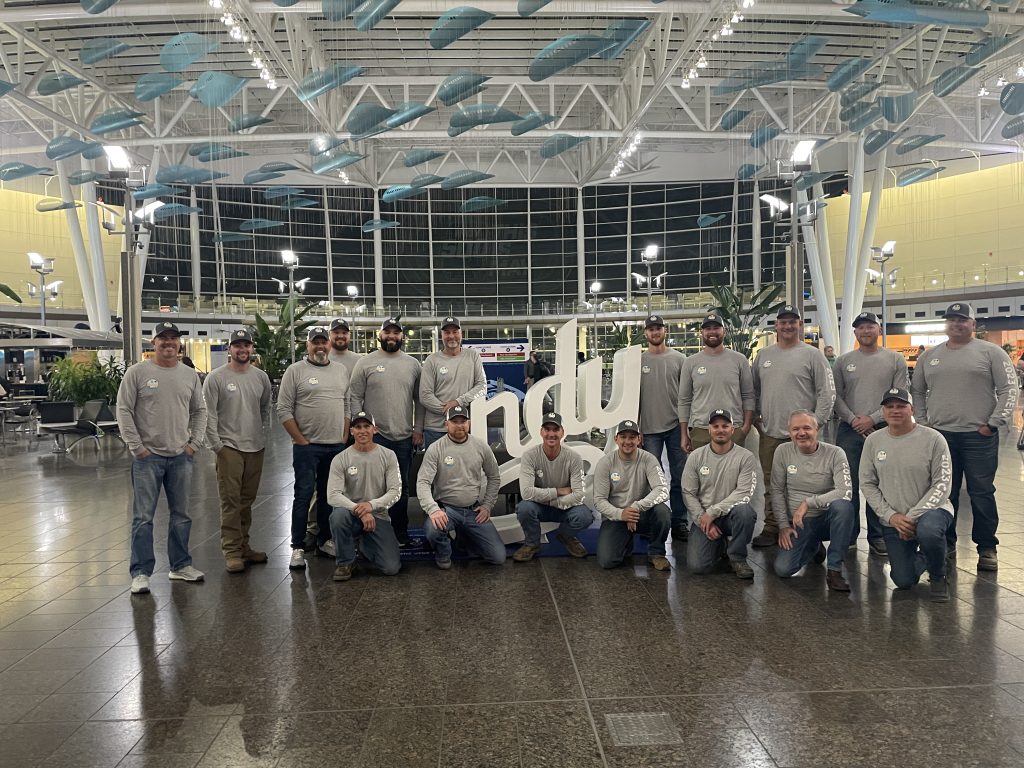
After a long day of travel, the Project Indiana team safely arrived in Guatemala on Thursday, April 27. Their journey included two flights and an hours-long drive to get to their first stop for the night.
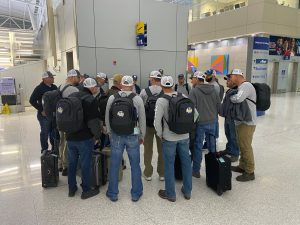
The Project Indiana team left Indianapolis for Guatemala City early Thursday morning. After a layover in Houston where there was a short flight delay, they and all of their luggage safely arrived in Guatemala City. The team connected with Project Indiana’s in-country liaison, Hugo, for a late lunch.
The team picked up the rental vehicles (seven pick-up trucks and an SUV) and started the drive to Huehuetenango (pronounced way-way-ten-an-go), Guatemala, where they were scheduled to spend the night in a hotel. The team got to experience some of the vastly different driving experiences of Guatemala – from the gridlock traffic of Guatemala City to more mountainous roads, both of which require a steady hand! Check out the April 27 SmugMug album for some videos.
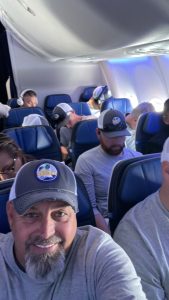
The hotel in Huehuetenango was a welcome sight after the team’s nearly 17-hour travel day. The hotel provided an opportunity for a good night of sleep, a hot shower and a good breakfast. Although, we hear a local rooster provided a 4:30 a.m. wake-up call. They are also now in the Mountain Time Zone, which is two hours behind most of Indiana.
The team was originally scheduled to depart Friday morning for the project site – the village of Pena Roja. However, the team is going to spend another night in Huehuetenango to allow for the shipping container of supplies to meet them there. The container, which departed Indiana Feb. 1 with an estimated 27-day shipping time, has experienced some delays along the way. But, that all seems to have been resolved now and it’s in transit with the supplies the crew will need to bring electricity to these 26 families who’ve never had the modern convenience in their homes. It is expected to arrive in Huehue by Friday evening.

A few of the village residents will travel to Huehue and help the team unload the container and so they can move the supplies the rest of the way up the mountain together. Unfortunately, the mountain roads from this point forward will not sustain the weight and size of a semi-truck needed to move the full shipping container. Regardless of the size of the vehicle, it will be a slow drive.
The project team will also spend some time Friday purchasing groceries. The team will have a cook to prepare meals for them on the mountain, and these groceries will provide him with the necessary supplies for that task. The updated plan is for the team to travel Saturday to Pena Roja, which is about a four-hour drive from Huehue. There, they will get settled, unload the container, and assess the project. The village residents have already set the 26 poles and dug the anchor holes for the project. They’ve also wired the inside of each home, so when the project is complete the power will flow to their homes. The plan is for the team and residents to spend the first two days pulling wire to have it all in place and begin hanging it on poles from there.
Education is a luxury we can help them afford
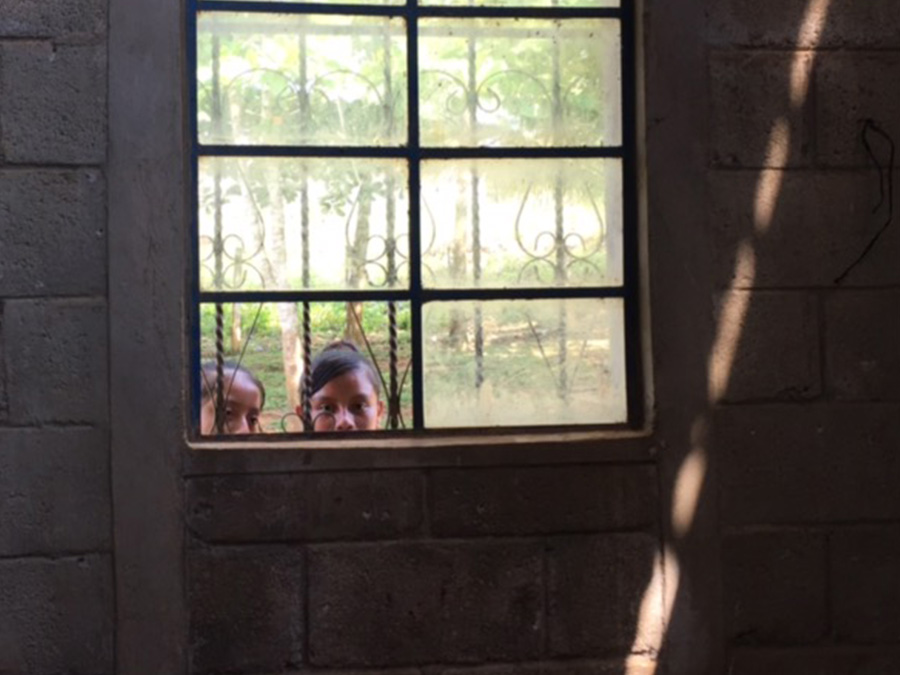
Compared to past Project Indiana sites, San Jacinto has an advanced education system. The students have the opportunity to attend school through ninth grade. The primary and secondary school buildings each have three classrooms. And, there’s a computer lab just up the hill along the dirt and rocky road. The computer lab is home to eight antiquated Dell computers that have been powered by a generator until the Indiana lineworkers came.
The children are often malnourished and have poor dental health. They often drink contaminated water, preventive dental care is rare and a diet we’d considered balanced for our children is often unattainable. This leads to stunted development. And, if they’re hungry or don’t feel well, learning is difficult.
And, the children often don’t have the luxury of childhood. They start working almost as soon as they can walk. Everyone in the family is expected to work and contribute to the family’s subsistence livelihood. And, even when education could be a choice, labor is more valued so they go to work.
With the introduction of electricity, life should become easier and education will become a luxury they can afford. That corn they used to spend five hours a day grinding can now be done in 15 minutes. And, they can refrigerate it and use it another day. They’ll have light in their homes at night that will allow both adults and children to study after the sun goes down.
Not only do their homes have light now, but their dreams are seeing the light of day as well.
Their weakness is always the children.
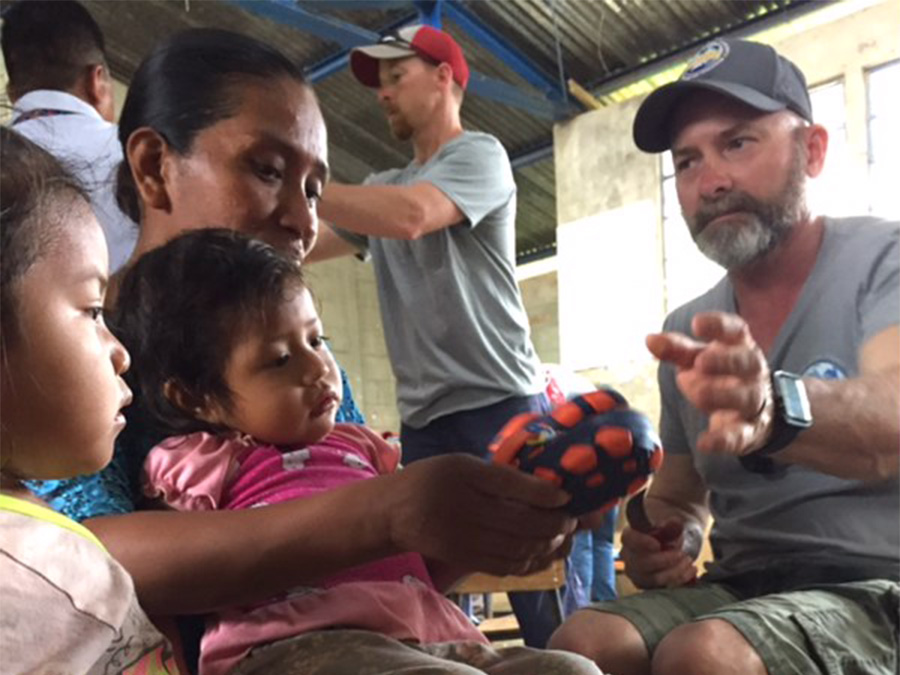
As with every Project Indiana electrification project, our team of lineworkers is focused on the seemingly insurmountable task ahead of them. They’re driven to get it done safely and are willing to work long days – and often get it done ahead of schedule. San Jacinto was no different.
There is another similar thread that runs through every project: the children of these villages capture the hearts of even the most hardened linemen. And, the San Jacinto children left the same deep impression.
The linemen are humbled by the children. How happy they are with so little. Their joy and spirit, the way they follow and watch the linemen, ready to help and play and learn. They often remind the linemen of their own children back in the states – curious, eager for attention and innocent. But, the Guatemalan children live a much harder life. Just as they would for their own children, the linemen can’t help but want more for them – a better life than their parents have had.
That makes the project team work even harder. They demand more of themselves than anyone ever asks of them. They do it back home and they do it on a mountaintop. It wasn’t enough for them to just give their time. They also dug deep in their wallets for the children.
They collected $1,000 and bought new shoes for every child in the village. 156 pairs and then the market threw in another three dozen pairs for a total of 192. And, they still had money left so they bought two pinatas, fireworks and 10 soccer balls.
They’d been challenged to a soccer match in the large, flat field behind the Catholic Church. The Hoosiers nipped the home squad 1-0 on a goal-scoring kick by Northeastern REMC’s Brent Buckles. Must’ve been the new soccer balls.
The lights are on.
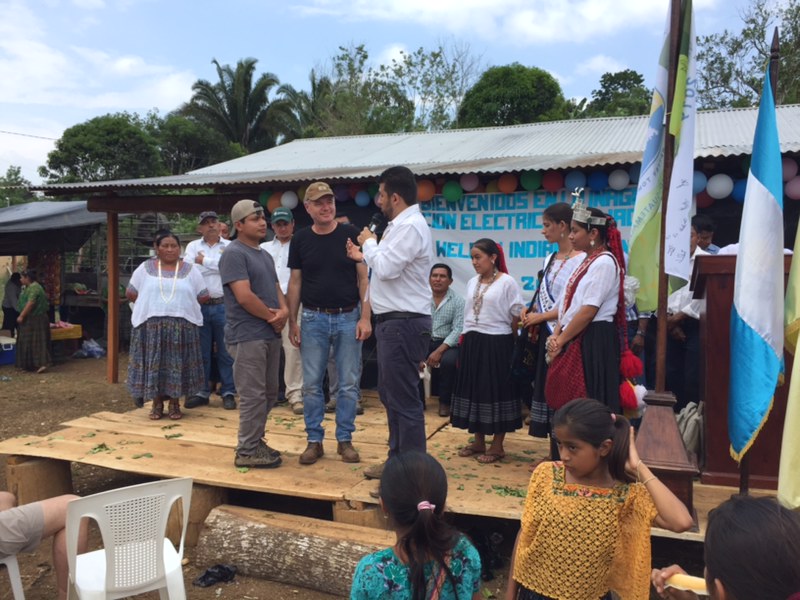
For the first time ever, the village of San Jacinto, Guatemala, has electricity and the lights are on in 90 homes, a school, two churches and a pump house.
To celebrate the occasion, the residents of the village hosted an “inauguration” ceremony today with the Project Indiana as the featured honorees. They were escorted into the village in parade-like style, followed by the national anthems of both countries, and remarks by officials.
The village residents will learn over time how to use electricity to improve their quality of life and to implement modern conveniences that we all take for granted. The things they have to work so very hard to accomplish and require great effort will become easier and they will develop new solutions and ways to support themselves. They’ve always had dreams and now they’re starting to develop plans.
Water and fire
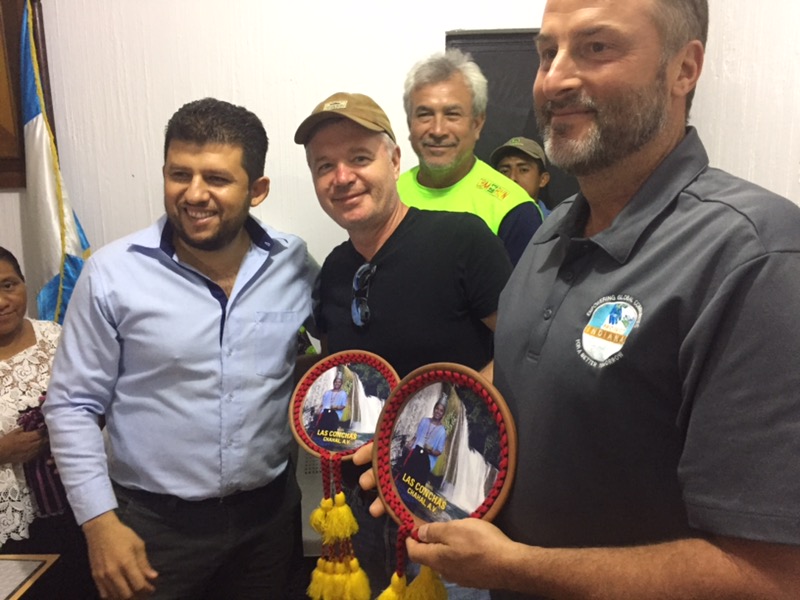
Last night, the mayor of the Chahal municipality (a municipality is more like a county in the United States) invited representatives of Project Indiana to a council meeting after visiting San Jacinto during the day. Several representatives from the village also attended.
The council and the residents thanked the Project Indiana team for helping to bringing electricity to the village. They described the new lights after sunset as “beautiful.”
Project Indiana Board Chair Ron Holcomb offered to purchase a new electric water pump for the village so they can again have access to water within the village. In return, the village residents agreed to put new wood-fired cook stoves with ventilator pipes in the kitchens.
They currently cook over open fires inside the homes. The village residents have only ever known cooking with a wood fire and it will be very difficult to to change that. But, the ventilation afforded with a stove pipe will be a vast improvement for the indoor air quality of these residents.
A day of work…and recreation

The Project Indiana team worked until about Noon today and then spent the afternoon on a little rest and recreation.
The San Jacinto area is home to a beautiful natural attraction – several waterfalls. These are depicted on a map in a couple of the photos posted today. These waterfalls are just downstream from the hydroelectric generating plant that powers the rural areas of the region, including San Jacinto.
The project team also shared a bit of Hoosier recreation with their new Guatemalan friends. They worked together to make cornhole boards from scrap wood and the mad skills of village resident with a chainsaw. Another village resident used old jeans to stitch bean bags. And, now they have cornhole games in San Jacinto.
Installation and education
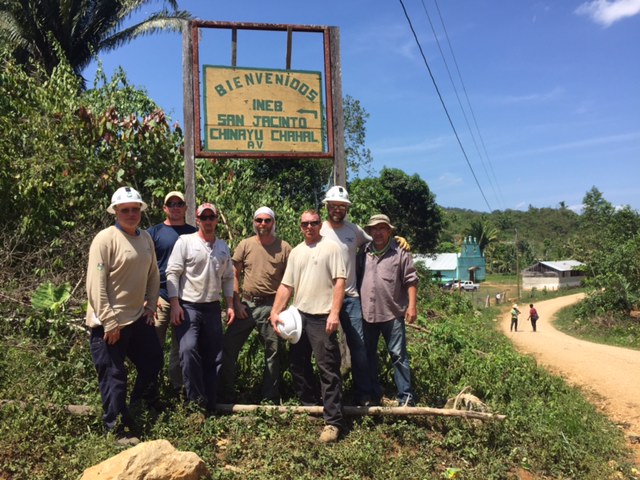
The guys worked a full day Saturday, heading out as soon as they finished 6:30 breakfast and worked until 6 to complete the installation of all primary, neutral and triplex wires. They still need to complete the service drop to the meter boxes and then to the homes of each of the village residents that are a part of this
Project Indiana Board Chair and Tipmont REMC CEO Ron Holcomb presented a “co-op utility sustainability 101” class to six directors from 13 communities in the local cooperative association, in addition to others from the area who were interested in learning about cooperatives. Plans are also being discussed for additional in-depth classes.
Saturday was sunny with temperatures in the mid- to high 80s with high humidity.
They’re driven to work
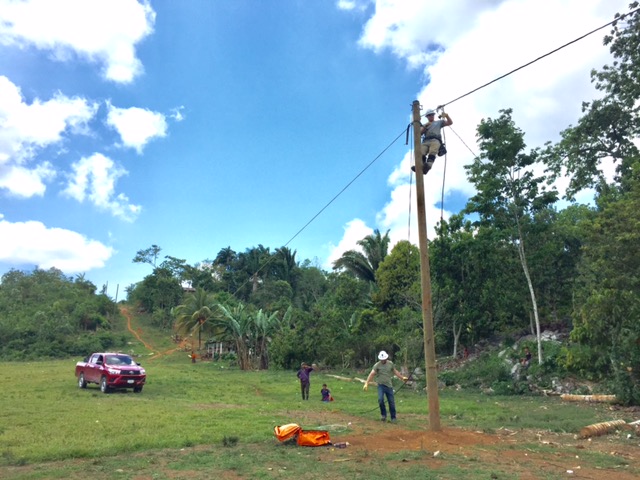
Task-oriented by nature, lineworkers are driven to accomplish what they have before them – no matter how big the job seems. The Project Indiana line team is no different.
Friday they strung another 10 spans of secondary triplex, seven spans of primary line and neural, connected multiple houses and wired many more homes. And, to no one’s surprise, there’s buzz about possibly finishing this monumental task ahead of schedule.
Project Indiana Board Chair and Tipmont REMC CEO Ron Holcomb will present to the local electric cooperative’s board of directors Saturday morning.
Steady progress Thursday
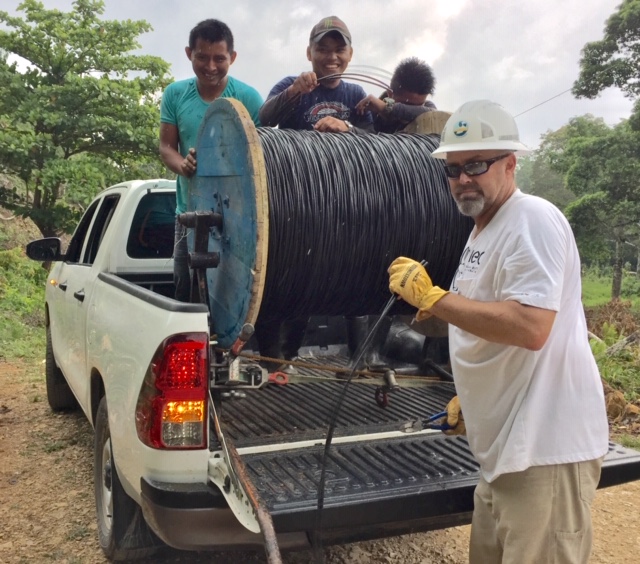
The project team made steady progress again Thursday. A total of 36 homes are now wired and secondary line has been pulled for most of the homes. Another pole is being set Friday.
Thursday’s weather started off in the 70s and was breezy and partly cloudy, then after another light rain it stayed overcast and got pretty humid.
Brent Buckles, Northeastern REMC, shared some gifts with the local school children. Brent’s wife is a teacher at a Fort Wayne Montessori school and her students sent some gifts for the San Jacinto school children. Brent took a few photos of the students to share with the American students, and then showed the photos to the San Jacinto students. Many residents of the village have never seen themselves in photographs.
